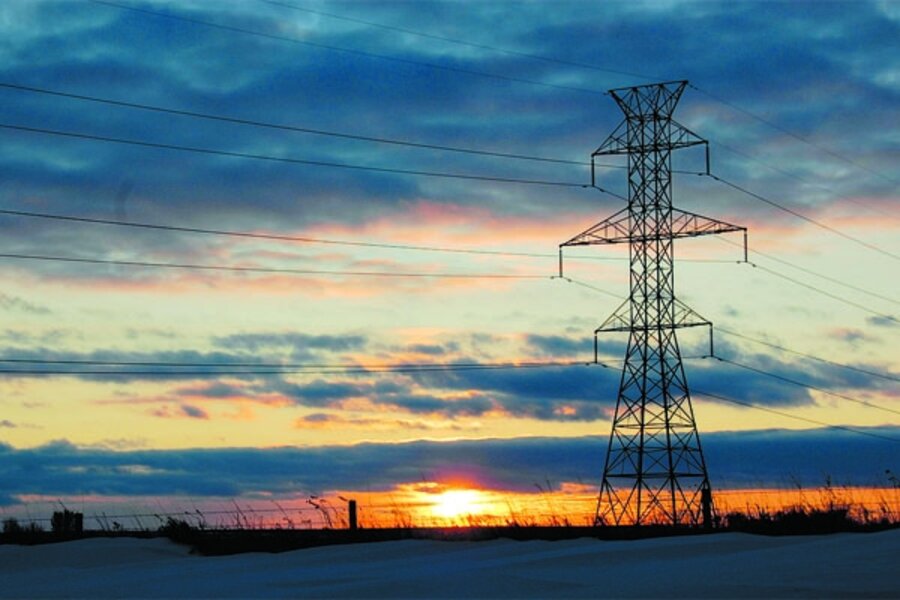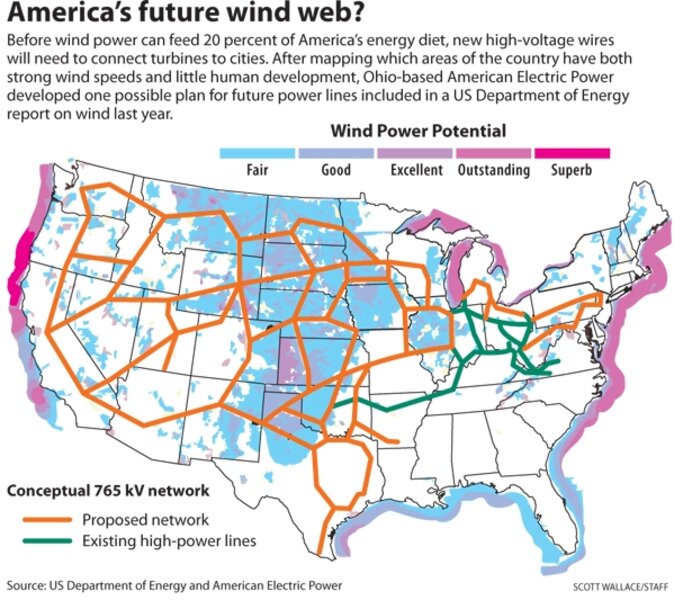America's future wind web?
Loading...
| MADISON, S.D.
Out across this wind-swept, wheat-growing state, Jeffrey Nelson sees a new crop rising – electricity from the world’s largest wind-turbine farms sending electrons thousands of miles east to Chicago or Boston.
But it’s a vision the South Dakota Wind Energy Association president says will never happen without something far larger, more controversial, and even more expensive: gigantic new high-voltage transmission lines.
Depending on whom you talk to, emerging plans to build 765,000 volt transmission lines to bring power from the “Saudi Arabia of wind” in the Dakotas to population centers in the Midwest and East Coast are either vital to the nation or a boondoggle waiting to happen.
“This state has vast resources it can’t use without building new power lines,” says Mr. Nelson, gesturing at lines on a grid map at the East River Electric Power Cooperative in Madison, where he is manager. “These high-voltage lines are like farm-to-market roads, but instead of wheat, it’s electricity being transported. We need to think in those terms.”
Many are clearly doing just that.
With political winds blowing toward renewable energy, power-line proposals are popping up to carry wind power around the country. President Obama has said he wants to see renewable wind from the plains help power cities like Chicago. The US Department of Energy last year reported that the nation could harvest 20 percent of its electricity from wind by 2020, much of it by tapping wind energy in places like South Dakota, which boasts the fourth best wind resource in the nation.
But to hook up to that steady 20- to 30-mile-per-hour breeze, the nation will need perhaps 15,000 miles of new transmission lines costing $80 billion, according to a new Joint Coordinated System Plan released Feb. 14, by the Midwest Independent System Operator (MISO), which coordinates regional power distribution.
“This is information we believe that our leaders need to consider as they begin work under a new administration and start defining our energy future,” John Bear, president of MISO said in a statement.
But grass-roots activists cite not only traditional “not-in-my-back-yard” (NIMBY) concerns about 150-to-200-foot-high towers, but question whether costs can be justified, compared with other renewable choices. As well, they note, such lines could carry far more “black electrons” from coal-fired power plants than green ones from wind.
A case in point involves Titan, which could one day be the largest wind farm in the world located in the middle of South Dakota. The Titan plan for 2,000 wind turbines generating 5,000 megawatts of power caused barely a ripple of media attention when announced last spring. Yet the plan to connect Titan to population centers – a $12 billion, 3,000–mile power line dubbed “Green Power Express” announced Feb. 9 – produced a gale of public attention among environmentalists.
While confirming that electrons from many types of power generation, including coal, would be carried by the proposed line, the key reason to build it is access to wind power, say company officials for Novi, Mich.-based ITC Holdings, which proposed the new line.
“The purpose of our plan is to build the infrastructure to where the wind blows most abundantly,” says Lisa Aragon, director of strategic initiatives at ITC. “As an independent transmission company, we can’t favor one type of energy over another. We do favor harnessing the wind for both environmental sustainability and energy security reasons.”
Environmentalist response
But critics have dubbed the new transmission line plan the “Green-wash Express” saying it could easily transmit as much or more energy produced by coal-fired power plants in South Dakota as wind energy.
“There’s no regulatory jurisdiction over this ‘green-power’ power line, not even a fig leaf that would require it to carry wind power,” says Paula Maccabee, counsel for Citizens Energy Task Force in Minneapolis, a group opposing the line. “It’s name is just a public relations slogan.”
Such plans, however, arrive amid a huge political push to harness wind power as one installment toward lessening US carbon emissions from energy production. President Obama has called for the United States to double renewable energy production in three years and get 25% of the nation's electricity from renewable resources by 2025. The new Obama stimulus plan includes $4 billion for a “Smart Grid” and new transmission lines.
Add to that the impetus generated as soon as next month when Congress is expected to begin weighing a new national “renewable electricity standard” that would require all electric utilities to ensure a portion of their power is from renewable sources. A draft bill before the US Senate calls for at least 20 percent of power from renewable sources by 2021 with gains in energy efficiency permitted to make up a quarter of the total.
Even without federal legislation, however, state mandates in nearly half of all states will require a significant percentage of power to be from renewable sources. In Minnesota, for instance, the state’s renewable portfolio standard calls for 25 percent renewable power by 2025.
To that end, there is CapX, a joint effort by 11 utilities that own transmission lines in Minnesota and surrounding regions to bring Dakota wind power to their city centers. Yet the new CapX line could one-day carry power transmitted from Big Stone II, a coal-fired power plant in South Dakota, documents show. And that has Jeremy Chipps, who lives near Lacrescent, Minn., where the line would run, up in arms to fight it.
Efficiency, cost, environmental concerns, and national security are Mr. Chipps’s talking points. Beside transmission line losses, the cost and potential of such lines as a terrorist target point to the need for more localized renewable power generation such as solar panels and local wind turbines, he says. And then there’s the coal-power carried on the lines.
“It really is time to deploy an energy production and smart-grid systems that are much safer, more intelligent, and much more efficient,” Chipps says. “If we do this, we won’t need massive, costly networks of new transmission lines.”
Who will pay for the lines?
Transmission costs traditionally end up paid for by rate-payers in the states that the lines cross. The Green Power Express, for instance, would cross seven states, each with its own siting requirements and ways of allocating who pays. So, how will South Dakotans feel if they end up paying higher electric rates for lines serving other states?
“To what extent do [rate-payers] have an appetite for increasing utility bills?” asks Dusty Johnson, chairman of the South Dakota Public Utility Commission. “There are some very significant geopolitical concerns when people start talking about multibillion [dollar] transmission projects.”
He agrees with Chipps that there is a “technological risk” and danger in investing in costly lines that might not be needed in the future.
“If it ends up being more cost effective for everyone to have small wind turbines in their backyard and solar panels on their roads, do we need these lines?” he asks. “I think we do. But such investments are not without risk.”
Other experts have concerns, too. Before the MISO report came out, Gordon van Welie of ISO New England and Stephen Whitley, president of New York Independent System Operator – grid operators for much of the East Coast – issued a pointed dissent from the MISO plan.
“Until additional scenarios that include the development of local resources are analyzed, we do not believe any single transmission plan can be presented as a solution to the integration of additional renewable energy resources in the United States,” the men wrote in a Feb. 4 letter.
Given the renewable development, energy efficiency, and likelihood of new ties to Canada, the need to construct long transmission lines to the Midwest “would likely be reduced and in turn overall transmission costs may be lower,” the system operators wrote.
Where to put the lines?
Even in the middle of wide open spaces, power line towers and wind turbines can reduce the area available to farm. Closer to urban areas, 150-200 foot towers spoiling the view and noise from crackling power lines can provoke local resistance that can delay construction for years.
“We’re advocating a streamlined process,” ITC’s Ms. Aragon says. “In many states there is no defined time for how long siting can go on.... If siting can’t be completed in the current [state] model, we may need to move to a federal siting process.”
Under federal law, the Federal Energy Regulatory Commission has designated several “national corridors” for power lines on the East and West coasts. It could designate others. If states can’t complete siting on power lines within the corridors, FERC can override states.
But there is also growing sentiment that FERC should not have the broad transmission siting authority granted under the Energy Policy Act of 2005.
Not surprisingly, parks-advocacy groups and others are furious at utility plans to build transmission lines near national parks and heritage sites like the Appalachian Trail and civil war battlefields. As many as 14 restive US senators reportedly agree and are poised to fight FERC authority. Those votes could be critical in any future battle over transmission lines.
Yet proponents of transmission lines say there’s not much question they will be built – only where, and who will pay.
“It will be critical for the federal and state government to provide some form of expedited regulatory approval, additional financial incentives and tax relief for new interstate transmission projects,” writes John Lamb, president of Clipper Windpower Development, developer of the Titan plan in an e-mail.
Out in South Dakota, the PUC’s Mr. Johnson is inclined to agree.
“We need a lot more transmission,” he says. “It’s hard in Washington to divvy up money according to merit and not politics. But if they do it on merit, South Dakota is going to do very well. We’ve got the wind.”
[Clarification: The proposed CapX transmission line mentioned above will not connect directly to the Big Stone II coal-fired power plant, as originally stated, but is expected to eventually carry power transmitted to it over a separate line from the plant.]






